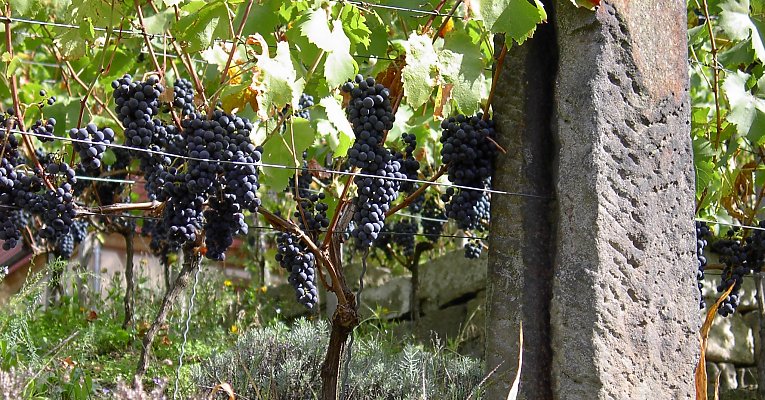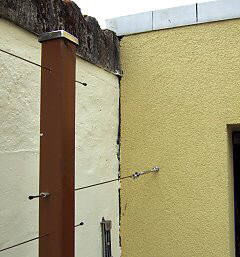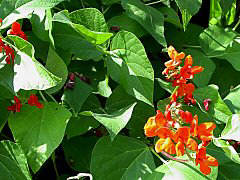Trellis Frames
Wire trellis frames are a classic, million-times tried-and-true system for fruit growing (viticulture, arboriculture), and can -- with stainless steel cable-- also be used in the home garden. Trellising with stainless steel cables is particularly practical for grapevines, raspberries, blackberries, or other espalier fruit trees. Here you can see the different possibilities, from the simplest wire trellising to the most complex pergolas. Under wire rope system 0050, you will find two of our pre-assembled kits.

Dimensions
In a vineyard, wire frames are often over 50 metres long. The trellises, subjected to the force of wind, will loosen and sag-- an aesthetic defect but not a functional one. In commercial orchards, the wires are then usually left slack and then retensioned every few years. In a private/house garden, short wire frames usually only have 2-3 stakes; for this-- small-scale free-standing rows of espaliered vines-- FassadenGrün offers stainless steel cable system 0050.
Single or Double Wires
Wire frames in vineyards typically have 2 wires - "double wires" on each tier. Crafty spacer systems are sometimes used to keep the wires apart. All this makes fastening the vines to the wire frame easier: the vine shoots can be inserted more quickly between the wires, and tying is no longer necessary. In the house garden, double wires are generally not needed.
Suitable Climbing Plants
In the home garden, wire frames are ideal for espalier fruit (for grapes, raspberries and blackberries)... Instead of stainless steel cables, simple wire ~ four or more horizontal lines (usually with double wire on each of the tiers) ~ is used. The sloped 'guy' (tension) ropes are suitable for additional greening, e.g. with annual climbing plants.

Stainless steel cable instead of single strand wire- a proven choice for a small installation in a private garden
The most basic wire frame: here, rot-resistant pointed robinia stakes are hammered into the ground (life span 10-25 yrs); the wires or ropes hang slack because high loads are created in taut wires which tend to pull the lateral stakes inwards. The stakes should therefore be set at an angle to the outside right from the start, or better -- braced using one of the three options below.
Here is an example of the simplest wire frame design-- a double espalier for raspberries-- without any guy ropes or reinforcement of the stakes to increase stability, and therefore with relatively slack wires to avoid pulling on the stakes. Three methods are possible to reinforce the solidity of such a structure. The three variants described below are available for additional bracing:
- Tether: tensioning / guying (standard solution)
- Strut (stakes / support posts)
- Crossbar (transverse beams)
In the case of robinia wood, the slanted posts are mitered as precisely as possible and screwed to the end posts. Here - in a vineyard - galvanised lock screws were used instead of stainless steel. The aggressive robinia wood, however, already dissolves the zinc coating, as you can see from the discolouration.
Usually the end posts are anchored in the ground at an angle towards the back. In vineyards, heavy stones are also buried in the ground with a wire attached, thus creating and strengthening the tension.
The anchors are not quite set on top but at about 2/3 the height of the post to prevent the post from bending in the direction of the tensioned wires or stainless steel cables.
Special case of horizontal guying. The wall eyelets required for it must be sealed in ('glued in') conically with compound mortar; plastic rawl plugs are not sufficient for such loads.
FassadenGrün recommends this ground/earth anchor for an easy and optimal "guying" --tensioning/anchoring. It is screwed into the ground like a screw and can support a load of several hundred kilograms.
The system 0050 is also useful when you can't drill into a post (for example, a neighbor does not want to see a hole in his wall). Here, dark varnished wooden posts were placed in metal ground spikes and fitted with zinc-plated cover caps (available in hardware stores). The guying of one side (in the photo above right) was done with a horizontal stainless steel cable mounted into another boundary wall.
As an alternative ('variant 2') to the guying described above, supporting stakes (made of e.g. robinia/lokust wood) can be used-- dug in and set on a stable pressure plate. This can be a natural stone slab, rock, or brick. The earth should first be compacted under the slab. Install the posts so that they lean outwards slightly to counteract the subsequent settling and tendency to shift inwards.
Trellis system for blackberries with double wires and staple nails and an additional support post in the middle.
In some cases it may be a good idea to tension cables vertically, especially for voluble twiners, since they love to wrap themselves around vertical supports. The easiest way is to guide the ropes through the cross beams (transoms) by drilling holes and fastening the ropes from behind with clamping rings.
Here the ropes of several fans intersect each other, creating a dense vine braid. A ground anchor is screwed into the bottom centre. Eyebolts WH 06060 or inexpensive staples nails KN 04055 are screwed into the frame of the wood. A cable can also be 'carried' by multiple eyelets (3 or 4), so that ultimately fewer cable clamps are required.
For changing the direction of the wires ropes, the ring screw element WH 06061 was used here.
Climbing aid made of intersecting soft wire-cable. Thin stainless steel wires are fundamentally "softer," more malleable, and thus more easily guided into angled forms, especially for short distances. In such cases, the comparatively harder wire makes tensioning more difficult.
For heavily-stressed eyelets (those serving as a 'feeder' for multiple outlets), we recommend the eyebolt WM 08080.
Installations with system 0050 can be susceptible to lateral wind pressure, especially in exposed positions with full vegetation. When in doubt, go with longer ground sleeves (drive them in as far as possible), reduce the height of the posts and the amount of tension in your ropes- or use double 'guying' (tension-anchoring) at the end of each row.
FassadenGrün recommends and sells this cable tension adjuster (GS-Nirosta), which can be added even after the wires have been mounted- onto taut or slack wires (to some extent also onto 3mm / 0.11 inch wire)- without cutting the wire, and can be finely tensioned at any time with a spanner/wrench.





































